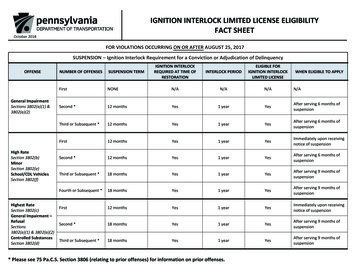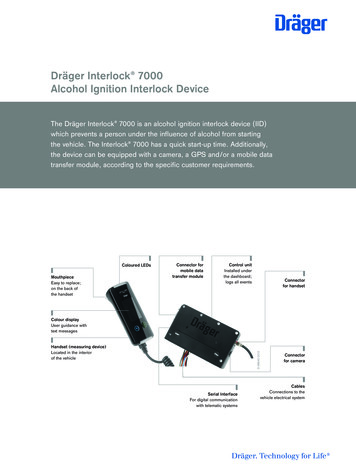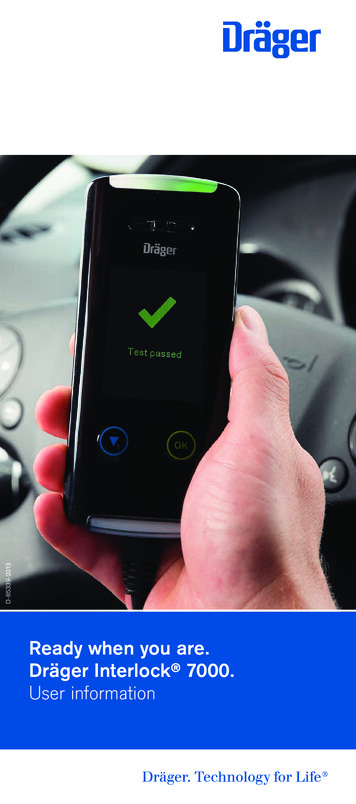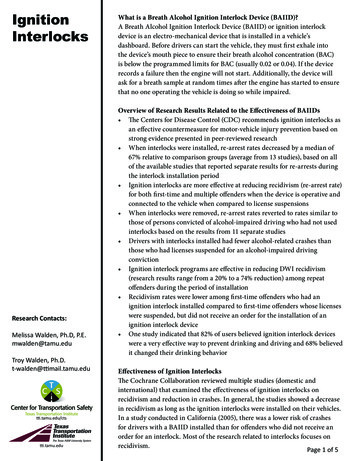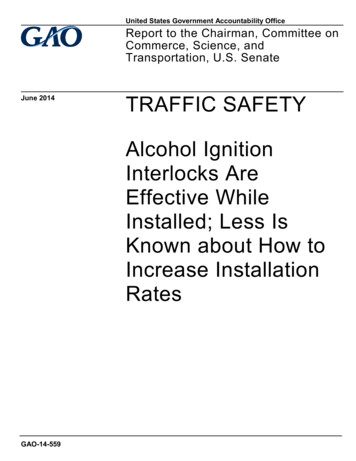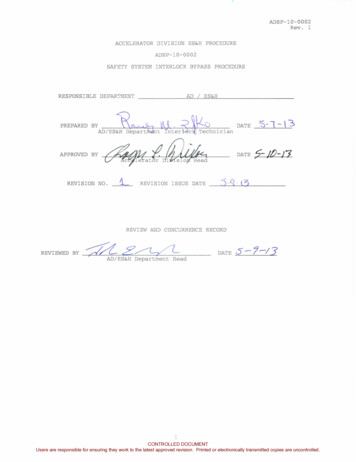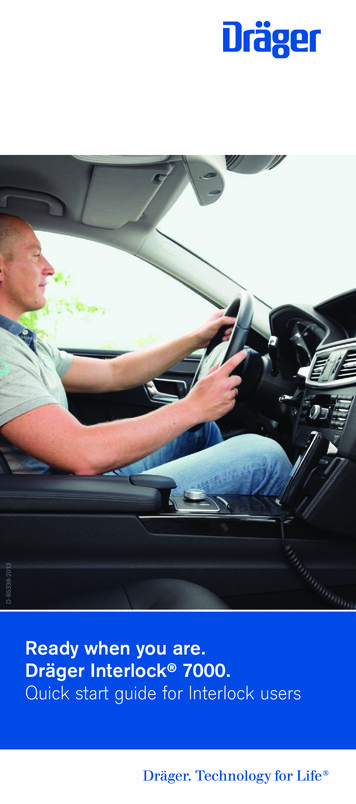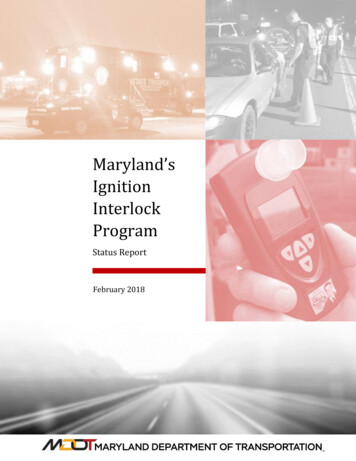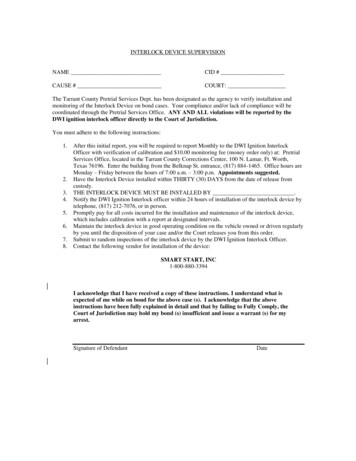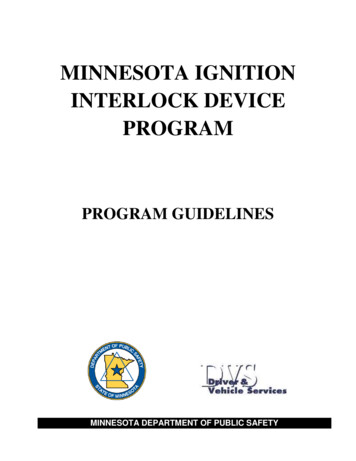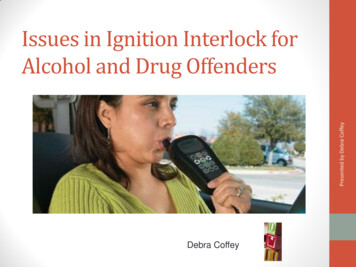
Transcription
Presented by Debra CoffeyIssues in Ignition Interlock forAlcohol and Drug OffendersDebra Coffey
Background Interlock has been around since the 80’s Ignition interlock programs currently in use in 50 states inthe U.S. 289,000 interlocks in use today; 1.4 million DWI’s in U.S.(18% penetration) 9,878 people were killed by a drunk driver in the U.S. lastyear – One every 53 minutes. 13 U.S. Interlock Manufacturers 10 in TexasPresented by Debra Coffey Research has proven interlocks effective in reducing DWIrecidivism 50% – 90%
Texas 145,000 arrested DWI’s a year 19,136 defendants on community supervision forfelony DWI. 38,071 defendants on community supervision formisdemeanor DWI.1,213 people were killed by a drunkdriver in Texas last year.Highest in the NationPresented by Debra CoffeyThe Lone Star State
Interlocks are more effective than licensesuspension Arizona, Oregon, New Mexico and Louisianahave cut deaths 30 % - 46% 18 states, plus California have a .08 Firstoffender laws; 16 states First offender - .15 Research indicates first offenders have drivendrunk 80 times before being arrested. To get to .08 BAC, a 160 lb. male, must drink 4drinks in an hourPresented by Debra CoffeyThe Facts
Research SummaryAre interlocks effective with 1st and repeat offenders?YES, Research demonstrates interlocks are effective with both 1stand repeat offenders in reducing DWI recidivism.New Mexico, W. Virginia, Maryland, Washington StateNew Mexico, Oregon and Arizona- significant crash reduction The Center for Disease Control (CDC) recommends Interlocksfor all convicted DUI offenders and considers drunk driving a NationalHealth issue The Insurance Institute for Highway Safety recommendsInterlocks for all convicted drunk drivers. Study – WA State –confirms IID saves lives and reduces recidivismCan interlocks indicate the likelihood of future offenses?YES, The data logger provides information on # of starts, date andtime of starts and BAC readingStudies: Alberta and TexasPresented by Debra Coffey 15 Peer reviewed studies
Research SummaryNHTSA –National Highway Traffic Safety Administration Case Studies of Ignition Interlock ProgramsKey Features for Ignition Interlock ProgramsEvaluation of the New Mexico Ignition Interlock ProgramAlcohol Interlock Curriculum for PractitionersIgnition Interlock – What you Need to Know: A Toolkit forPolicymakers, Highway Safety Professionals and Advocates The Use of Alcohol Ignition Interlocks for Reducing ImpairedDriving RecidivismPresented by Debra Coffey www.NHTSA.gov
Research SummaryTIRF - Traffic Injury Research Foundation Alcohol Interlock Programs – Vendor Oversight The Implementation of Alcohol Interlocks for Offenders – A Roadmap Understanding behavioural patterns of interlocked offenders toinform the efficient and effective implementation of interlockprograms The Implementation of Alcohol Interlocks for First Offenders – A CaseStudy Developed an Alcohol Interlock Curriculum for Practitioners –includes a teaching guide Host to the International Ignition Interlock Symposium, 12th year NHTSA grant to provide technical assistance to States onImplementation and Penetration of Ignition Interlock programsPresented by Debra Coffeywww.tirf.ca Since 2000, TIRF has published 35 Case Studies, Primers,Practitioners Guides and Conference Proceedings
Research SummaryPIRE – Pacific Institute for Research and Evaluationwww.PIRE.org Evaluation of a Program to Motivate Impaired Driving Offendersto Install Ignition Interlocks Evaluation of Ignition Interlock Programs International Ignition Interlock Work group - TransportationSafety Research Board– Dr. Paul Marques, ChairPresented by Debra Coffey Behavioral Measures of Drinking Patterns in the Interlock Record
Texas Law Subsequent Offender Intox. Assault and Intox. ManslaughterCCP 17.441Probation 1st Offender with BrAC .15 or greater 1st Offenders under 21 All Subsequent OffendersCCP 42.12 § 13, TRC 521.342 (b)Presented by Debra CoffeyBond
Texas Law Subsequent Offender granted an occupationallicense CSCD supervises person issued ODLAssess fee 25- 60 for supervision paid by offenderCSCD can require offenders on ODL submit todrug/alcohol testingTRC 521.246, 521.2462Presented by Debra CoffeyOccupational
Federal Law State incentive grants 20 million NO Hard License suspensionPresented by Debra Coffey MAP 21
What is an Interlock? AKA: Breathalyzer, Interlock, BAIID, IID Requires a breath sample, fail level determined bystate, typically .030 (BrAC) breath alcohol contentto pass.Presented by Debra Coffey An electronic device wired into the ignitionsystem of a vehicle which requires the user topass a breath alcohol test in order to start thevehicle.
Purpose of Interlock Alternative to jail Allows offender to work, support family, paycourt fees, attorney Participate in treatment Remain productive member of communityand family Separates drinking from drivingPresented by Debra Coffey Keeps offender licensed and insured
ProbationParoleBondLicense reinstatement and licensing RepeatoffendersDeferred Prosecution1st offenders1st offenders with High BAC (.15 or higher)Repeat offendersFamily Violence (alcohol a factor)Court Visitation – Domestic courts (alcohol factor)VoluntaryPresented by Debra CoffeyHow are Interlocks Used
Monitoring Tool Reporting and Supervision Prevent Repeat Behavior Form of Incapacitation Bridge license suspension to fullreinstatement Provide public safety Research supports reduction recidivism among1st and Repeat offenders – 15 Peer reviewedstudiesPresented by Debra CoffeyBenefits of Interlock
Interlock Technical Standards NHTSA, Released May 8, 2013 TDPS State oversightTexas Administrative Code, Ch. 19 Breath Alcohol Testing Regulations Device certification Device programming and specifications Inspection of vendor facilitiesPresented by Debra CoffeyDevice specifications – 1992Final May 8, 2014
Presented by Debra Coffey
Presented by Debra CoffeyIntroduction toIgnition InterlocksAn ignition interlock combines breath alcohol sensing andmicro-computer technology in a device that is designed to stopdrunk driving.
Presented by Debra Coffey The interlock device is installed in a vehicle Linked to the ignition system
Presented by Debra CoffeyIn order to start an interlock-equipped vehicle the driver must first supply abreath sample.– The sample is analyzed for alcohol.– If the alcohol level is above the fail set point, the vehicle cannotbe started.– If the level is below the pre-set limit, the vehicle can be startedand operated normally.
Reports forwarded to the Probation officer or Court authority.Presented by Debra CoffeyEvents relating to the use of the interlock device and the vehicle arerecorded on a memory chip for retrieval during servicing, at which timedata is uploaded to a central server.
The Technology Fuel Cell – Specific to Alcohol Anti-circumvention features Programmable features Running Re-test / Rolling Re-test Data recorder Reports to authorities Restricted Drive Times - CurfewPresented by Debra Coffey Sensor Cell – older less reliable – 14 states still allow
Language and visual display BRAC threshold .030 Lock-out time – 15 min. temp lockout Stall protection – 3min in traffic Pull over notice – 6 min. to take the test Recall notice – 72 hours Violations – combination of 5 Photo ID – identify user Wireless/Cellular/ GPS/ Facial DetectionPresented by Debra CoffeyDevice Features
Answers the Question WhoTook the Test? Mandatory in Hawaii, TN, IL, WA, NY, MO, Vermont – Repeat offenders DWI Courts MI and by court order in TexasPresented by Debra CoffeyCamera – Photo
Daily downloads Authority determines what they receive and howreported Violations reporting Picture downloads Client convenience Time between service visits Instant equipment error reportingPresented by Debra CoffeyCellular
Schedule daily monitoring Based on pre-defined reporting criteria Event notification Validated by live operator Operator can verify with GPS capability Contact authority per procedure they prescribePresented by Debra CoffeyE-911
Real time mapping capability Determine patterns of where offenders go Set inclusion or exclusion zones Alert monitors when offender has enteredexclusion zone Alert offender when they have entered anexclusion zone. Vehicle tracking when needed, i.e. Violations areoccurringPresented by Debra CoffeyGPS
Temperature and pressure gauges Sealed wiring Voice pattern, tone, detection systemPrevents balloons, altered air User Identification – Camera Facial proximity Data logger informationTime and date stamps all events,attempted eventsPresented by Debra CoffeyAnti-circumvention systems
273 interlock service points in Texas Installation takes approx. 1 hour Return every 30 days Install - 50.00 Monthly - 2.30 a day or 69.00 mo. Reports sent to authorities via email Texas – reports sent next business day Authorities access to client information throughWebPresented by Debra CoffeyInstallation and Costs
Client training – written, hands on – SSI AP Service provider to conduct physicaltamper inspections If tamper found report to monitoringauthority Emergency 24 hour toll free number Emergency assistance within 48 hours Provide required testimony in proceedingsPresented by Debra CoffeyService
Presented by Debra CoffeyTexas Offender interlock programs areadministered either by courts as a conditionof bond, probation, occupational license,parole condition.
Monitoring/Reporting DPS - Standardize reports so all vendors are using samereport format. 30 day monitoring – Wireless provides daily Violation download – return to service center Reports sent in next day Data a predictor of recidivism – PIRE Research Information is useful in planning treatment – IID part ofDWI court treatment plan Data useful in determining program duration- Earn their way off program / Exit strategies ( WA, MD and CO)- Reward offenders doing well with early termination/ longer time betweenservice visits – 60 - 90 daysPresented by Debra Coffey Specify authority responsible for monitoring and sanctionsfor violators.
Presented by Debra CoffeySample ReportSubmitted to Monitoring Authority
Presented by Debra Coffey
Presented by Debra Coffey
Presented by Debra Coffey
Car stops in middle of road Gas fumes and Perfume Battery drain Cigarette smoke Cinnamon rolls and donuts Pool chlorine Spicy foods Windshield washer fluid Teeth whitenerPresented by Debra CoffeyTruths and Myths
Mouth AlcoholContaminants Temperature and Altitude-40 to 185 degrees F ; 11,482 ft. elevation Running re-tests15-45 min. random Family member inconvenience Costs Anyone can take the test-40 Yr. Old Virgin-ABC – What would you do?Presented by Debra CoffeyInterlock Concerns
Reliability of device Access to supporting documents and reports Testimony to corroborate test results and reports Breath VolumeRequires device knowledge Who took the testFeatures – eliminate bystander mythPositive ID technologyPresented by Debra CoffeyCourt/ Prosecution Concerns
1.Offenders claim they do not need an Interlock because they do not intendto drive: This is usually false. Up to 75% of drivers will drive with asuspended license.2.Offenders claim they do not own a vehicle. While offenders may not own avehicle they frequently have access to and drive a vehicle. The law does notrequire the offender own the vehicle, they only need access to one3.Offenders fail to install the interlock once an order is made: This is true andan important issue for the judiciary. One study showed that as few as 22% ofthose offenders ordered to install an Interlock actually complied, so follow-upis critical.4.Offenders fail to drive the interlock-equipped vehicle: This happens rarely,but it is important to ensure that offenders actually drive the Interlockequipped vehicle. This can be accomplished by watching the number ofengine starts or miles driven.Presented by Debra CoffeyTop 4 ways offenders will try to keepfrom having the IID requirement
Offenders do not install Program Funding/Program costs/Programdevelopment Lack of information and education on how theInterlock works Supporting legislation; conflicts with State &Federal policy and unfunded mandates Workload Exiting the Interlock programPresented by Debra CoffeyInterlock Challenges
Public Safety Tool or Aggravation A study in New Mexico showed when asked, 87%of offenders felt interlocks reduced drinking anddriving. 85% thought having the interlock on their carwas a fair sanction.Presented by Debra CoffeyOffender’s Perception
Public Perception 88% support interlock on all convicted drunk drivers(Center for Excellence in Rural Safety, May 2010) 84% support interlocks for convicted drunk drivers(Insurance Institute for Highway Safety, 2009) Over 3 of 4 persons support Interlock for first timeconvicted drivers ( AAA, 2011)Presented by Debra CoffeyPublic Supports Interlocks for 1st time Offenders
Ensure participants maintain sobriety Increase accountability of participants by monitoringsobriety Provide alternatives to the court system Reduce DWI recidivism by addressing sobriety issues andmodifying behavior Provide for efficient use of caseload management Provide for flexibility in supervision based on offenderscompliance i.e., Rewards and Punishment Use of technology as important role in long term riskreduction by supporting efforts to address alcohol issues Use of sanctions that are cost effective and cost efficientPresented by Debra CoffeyUsing Technology toMonitor Offenders
Interlocks Globally Commercial Applications Sweden has 40,000 interlocks 9 million people Not necessarily an offender marketPresented by Debra Coffey North Carolina
Presented by Debra CoffeySchool Busses in Russia
Buses, trucks, taxis, trains, construction e etc Presented by Debra CoffeyTransportation: Busses, Trucks, Taxi,Trains, Construction Equipment,Dangerous goods, etc.
Not limited to transportation, or even things that movePresented by Debra Coffey Industrial machinery, access control—i.e. wide variety ofsafety sensitive applications
Future Technologies & ApplicationsDADSS Interlocks in all Cars Driver Alcohol Detection Safety Systems www.dadss.org Cooperative research with Car Manufacturer’s 10 million dollars Vehicle Proto-Type / Research Vehicle end of 2013 Must be Passive, not hassle sober driver, relativelyinexpensive Less than 1 secondPresented by Debra Coffey Advanced Technologies
Driver Alcohol Detection Systems forAuto Safety1. Tissue SpectrometryEstimation of BAC by measuring how much light has beenabsorbed at particular wavelength from a beam of NearInfrared (NIR) reflected from the subject skinTouch-based systems that require skin contact2. Distant SpectrometryIR or laser light is transmitted to the subject from a sourcethat receives and analyses the reflected and absorbedspectrum, to assess chemical content of tissue or liquidin vaporNo skin contact is requiredPresented by Debra CoffeyTechnology Types
What is Alternative Alcohol Monitoring? Types of Alcohol Monitoring IN HOM, SCRAM, TAD, Actsoft, MEMS,Wrist Guard, VI-CAP, Visatel, others Background of Development New Mexico legislation – No Car Sobriety monitoring - JudgesPresented by Debra CoffeyAlternative AlcoholMonitoring Technology
Alternative Alcohol MonitoringPresented by Debra Coffey In Home Alcohol Monitoring - Portable Continuous Alcohol Monitoring SCRAM, TAD, ActSoft
Presented by Debra CoffeySMART START IN-HOM
BrAC 0.000 PassPresented by Debra CoffeyThursday, June 17, 2009 10:13:33 am
Presented by Debra Coffey
Advances in Drug Testing 5 panel screen Roadside and supervision use 6 minute test Non invasive Screening device Identifies user – Chain of custodyPresented by Debra CoffeyIntelligent Fingerprint
Technology key component of monitoring andsupervision People are going to drive Technologies are additional Tools Combine with Treatment, Information andEducation Criminologist agree – Swift and Certain Penaltiesare more effective Insert the “intervention” during the teachablemomentPresented by Debra CoffeyConclusions
Separating Drinking fromDriving 645 Million Safe starts usingSmart Start Interlock7 million Illegal starts preventedPresented by Debra CoffeySince 1994
Presented by Debra Coffey
Presented by Debra CoffeyInterlocks Saving LivesThe benefits are clear Everyone benefits from efforts toSeparate Drinking from Driving .
Debra CoffeyVP, Government AffairsSmart Start, Inc.1-800-880-3394, ext. 225817-307-4992 – cellDCoffey@SmartStartInc.comPresented by Debra CoffeyQuestions?
3. Offenders fail to install the interlock once an order is made: This is true and an important issue for the judiciary. One study showed that as few as 22% of those offenders ordered to install an Interlock actually complied, so follow-up is critical. 4. Offenders fail to drive the interlock-equipped vehicle: This happens rarely,
